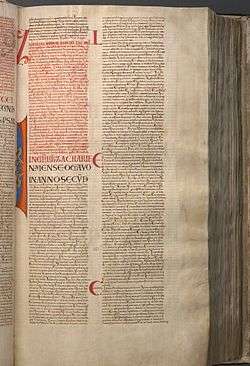Zechariah 5
| Zechariah 5 | |
|---|---|
 The beginning part of the Book of Zechariah (1:1-6:15) in Latin in Codex Gigas, made around 13th century. | |
| Book | Book of Zechariah |
| Bible part | Old Testament |
| Order in the Bible part | 38 |
| Category | Nevi'im |
Zechariah 5 is the fifth chapter of the Book of Zechariah in the Hebrew Bible or the Old Testament of the Christian Bible.[1][2] This book contains the prophecies spoken by the prophet Zechariah, and is a part of the Book of the Twelve Minor Prophets.[3][4]
Text
- The original text is written in Hebrew language.
- This chapter is divided into 11 verses.
Textual versions
Some most ancient manuscripts containing this chapter in Hebrew language:
- Masoretic Text (10th century)
- Dead Sea Scrolls: (2nd century BC)[5][6]
- 4Q80 (4QXIIe): extant: verses 8-11[5]
Ancient translations in Koine Greek:
- Septuagint (3rd century BC)
- Theodotion version (~AD 180)
Structure
NKJV groups this chapter into:
- Zechariah 5:1-4 = Vision of the Flying Scroll
- Zechariah 5:5-11 = Vision of the Woman in a Basket
Verse 7
- And, behold, there was lifted up a talent of lead:
- and this is a woman that sitteth in the midst of the ephah.[7]
- "There was lifted up a talent of lead": As the prophet gazed, the leaden cover of the ephah was raised, so that the contents became visible. The word rendered "talent" (kikkar) denotes a circle. It is used in Genesis 13:10, 12, for the tract of country of which the Jordan was the centre, and in 1 Samuel 2:36 for a round loaf. Here it means a disc or circular plate which formed the cover of the round shaped ephah. In the next verse it is called, "the weight of lead." [8]
- "A talent of lead": A kikkar (or cicar), or "talent of silver", with the Jews, was equal to three thousand shekels, as may be gathered from Exodus 38:24 and weighed a hundred and twenty five pounds;[9] or, as others, a hundred and twenty,[10] and, according to the more exact account of Dr. Arbuthnot, a hundred and thirteen pounds, ten ounces, one pennyweight, and ten and two seventh grains of our Troy weight. A Babylonish talent, according to Aelianus,[11] weighed seventy two Attic pounds; and an Attic mina, or pound, weighed a hundred drachmas; so that it was of the weight of seven thousand two hundred such drachmas. An Alexandrian talent was equal to twelve thousand Attic drachmas; and these the same with a hundred and twenty five Roman libras or pounds; which talent is supposed to be the same with that of Moses. The Roman talent contained seventy two Italic minas, which were the same with the Roman libras.[12] But since the Hebrew word "cicar" signifies anything plain, and what is extended like a cake, as Arias Montanus observes,[13] it may here intend a plate of lead, which was laid over the mouth of the "ephah", as a lid unto it; though indeed it is afterwards called, "a stone of lead", and so seems to design a weight.[14]
- "This is a woman" - Literally, "one woman," all sin being concentrated and personified in one, as he goes on to speak of her as the, personified, wickedness. The sitting may represent her abiding tranquil condition in her sins, according to the climax in Psalm 1:1-6, "and hath not sat in the seat of the scornful" Psalm 1:1; and, "thou sittest and speakest against thy brother" Psalm 50:20; (Lap.), "not standing as by the way, but sitting, as if of set purpose, of custom and habit." "Whoso hath peace in sins is not far from lying down in them, so that, oppressed by a spirit of slumber, he neither sees light, nor feels any blow, but is kept down by the leaden talent of his obduracy."[15]
- "woman" — for comparison of "wickedness" to a woman, Proverbs 2:16; 5:3, 4. In personifying abstract terms, the feminine is used, as the idea of giving birth to life is associated with woman.e.[16]
See also
- Related Bible parts: Zechariah 1, Zechariah 2, Zechariah 3, Zechariah 4, Zechariah 6
Notes and references
- ↑ Collins 2014.
- ↑ Hayes 2015.
- ↑ Metzger, Bruce M., et al. The Oxford Companion to the Bible. New York: Oxford University Press, 1993.
- ↑ Keck, Leander E. 1996. The New Interpreter's Bible: Volume: VII. Nashville: Abingdon.
- 1 2 Dead sea scrolls - Zechariah
- ↑ Timothy A. J. Jull; Douglas J. Donahue; Magen Broshi; Emanuel Tov (1995). "Radiocarbon Dating of Scrolls and Linen Fragments from the Judean Desert". Radiocarbon. 38 (1): 14. Retrieved 26 November 2014.
- ↑ Zechariah 5:7
- ↑ Joseph S. Exell; Henry Donald Maurice Spence-Jones (Editors). The Pulpit Commentary. 23 volumes. First publication: 1890.

- ↑ Epiphanius de Mensuris & Ponderibus.
- ↑ Hebraei apud Buxtorf. Lex. Heb. in rad.
- ↑ Aelianus. Var. Hist. l. 1. c. 22
- ↑ See Prideaux's Preface to Connexion, &c. vol. 1. p. 18, 19, &c.
- ↑ Arias Montanus. Ephron, sive de Siclo, prope finem.
- ↑ John Gill. John Gill's Exposition of the Entire Bible. Exposition of the Old and New Testament. Published in 1746-1763.

- ↑ Barnes, Albert. Notes on the Old Testament. London, Blackie & Son, 1884. Reprint, Grand Rapids: Baker Books, 1998.

- ↑ Robert Jamieson, Andrew Robert Fausset; David Brown. Jamieson, Fausset, and Brown's Commentary On the Whole Bible. 1871.

Bibliography
- Collins, John J. (2014). Introduction to the Hebrew Scriptures. Fortress Press.
- Hayes, Christine (2015). Introduction to the Bible. Yale University Press.
External links
Jewish
Christian
This article is issued from
Wikipedia.
The text is licensed under Creative Commons - Attribution - Sharealike.
Additional terms may apply for the media files.